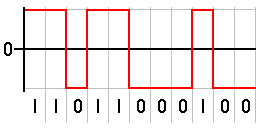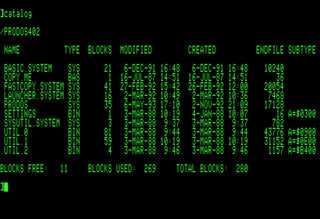
The Commodore 1541 is a floppy disk drive which was made by Commodore International for the Commodore 64 (C64), Commodore's most popular home computer. The best-known floppy disk drive for the C64, the 1541 is a single-sided 170-kilobyte drive for 5¼" disks. The 1541 directly followed the Commodore 1540.

The Commodore 1570 is a 5¼" floppy disk drive for the Commodore 128 home/personal computer. It is a single-sided, 170 kB version of the Commodore 1571, released as a stopgap measure when Commodore International was unable to provide sufficient quantities of 1571s due to a shortage of double-sided drive mechanisms. Like the 1571, it can read and write both GCR and MFM disk formats. The 1570 utilizes a 1571 logic board in a cream-colored original-1541-like case with a drive mechanism similar to the 1541's except that it was equipped with track-zero detection. Like the 1571, its built-in DOS provides a data burst mode for transferring data to the C128 computer at a faster speed than a 1541 can. Its ROM also contains some DOS bug fixes that didn't appear in the 1571 until much later. The 1570 can read and write all single-sided CP/M-format disks that the 1571 can access.

A floppy disk, also known as a floppy, diskette, or simply disk, is a type of disk storage composed of a disk of thin and flexible magnetic storage medium, sealed in a rectangular plastic enclosure lined with fabric that removes dust particles. Floppy disks are read and written by a floppy disk drive (FDD).

In telecommunication, a line code is a pattern of voltage, current, or photons used to represent digital data transmitted down a transmission line. This repertoire of signals is usually called a constrained code in data storage systems. Some signals are more prone to error than others when conveyed over a communication channel as the physics of the communication or storage medium constrains the repertoire of signals that can be used reliably.

The 64DD is a magnetic disk drive peripheral for the Nintendo 64 game console developed by Nintendo. It was originally announced in 1995, prior to the Nintendo 64's 1996 launch, and after numerous delays was finally released only in Japan on December 1, 1999. The "64" references both the Nintendo 64 console and the 64 MB storage capacity of the disks, and "DD" is short for "disk drive" or "dynamic drive".

ProDOS is the name of two similar operating systems for the Apple II series of personal computers. The original ProDOS, renamed ProDOS 8 in version 1.2, is the last official operating system usable by all 8-bit Apple II series computers, and was distributed from 1983 to 1993. The other, ProDOS 16, was a stop-gap solution for the 16-bit Apple IIGS that was replaced by GS/OS within two years.
Disk formatting is the process of preparing a data storage device such as a hard disk drive, solid-state drive, floppy disk or USB flash drive for initial use. In some cases, the formatting operation may also create one or more new file systems. The first part of the formatting process that performs basic medium preparation is often referred to as "low-level formatting". Partitioning is the common term for the second part of the process, making the data storage device visible to an operating system. The third part of the process, usually termed "high-level formatting" most often refers to the process of generating a new file system. In some operating systems all or parts of these three processes can be combined or repeated at different levels and the term "format" is understood to mean an operation in which a new disk medium is fully prepared to store files.
Modified Frequency Modulation, commonly MFM, is a run-length limited (RLL) coding scheme used to encode the actual data-bits on most floppy disks. It was first introduced in disk drives with the IBM 3330 hard disk drive in 1970. Floppy disk drive hardware examples include Amiga, most CP/M machines as well as IBM PC compatibles. MFM is a modification to the original digital FM scheme for encoding data on single-density floppy disks and some early hard disk drives.
Copy-on-write, sometimes referred to as implicit sharing or shadowing, is a resource-management technique used in computer programming to efficiently implement a "duplicate" or "copy" operation on modifiable resources. If a resource is duplicated but not modified, it is not necessary to create a new resource; the resource can be shared between the copy and the original. Modifications must still create a copy, hence the technique: the copy operation is deferred to the first write. By sharing resources in this way, it is possible to significantly reduce the resource consumption of unmodified copies, while adding a small overhead to resource-modifying operations.

The Commodore 1530 (C2N) Datasette, later also Datassette is Commodore's dedicated magnetic tape data storage device. Using compact cassettes as the storage medium, it provided inexpensive storage to Commodore's 8-bit home/personal computers, notably the PET, VIC-20, and C64. A physically similar model, Commodore 1531, was made for the Commodore 16 and Plus/4 series computers.
Run-length limited or RLL coding is a line coding technique that is used to send arbitrary data over a communications channel with bandwidth limits. RLL codes are defined by four main parameters: m, n, d, k. The first two, m/n, refer to the rate of the code, while the remaining two specify the minimal d and maximal k number of zeroes between consecutive ones. This is used in both telecommunication and storage systems that move a medium past a fixed recording head.

In computer science, a sparse file is a type of computer file that attempts to use file system space more efficiently when the file itself is partially empty. This is achieved by writing brief information (metadata) representing the empty blocks to disk instead of the actual "empty" space which makes up the block, using less disk space. The full block size is written to disk as the actual size only when the block contains "real" (non-empty) data.

In data storage, disk mirroring is the replication of logical disk volumes onto separate physical hard disks in real time to ensure continuous availability. It is most commonly used in RAID 1. A mirrored volume is a complete logical representation of separate volume copies.
AdvFS, also known as Tru64 UNIX Advanced File System, is a file system developed in the late 1980s to mid-1990s by Digital Equipment Corporation for their OSF/1 version of the Unix operating system. In June 2008, it was released as free software under the GNU GPLv2 license. AdvFS has been used in high-availability systems where fast recovery from downtime is essential.
A diskless shared-root cluster is a way to manage several machines at the same time. Instead of each having its own operating system (OS) on its local disk, there is only one image of the OS available on a server, and all the nodes use the same image.
Data erasure is a software-based method of overwriting the data that aims to completely destroy all electronic data residing on a hard disk drive or other digital media by using zeros and ones to overwrite data onto all sectors of the device. By overwriting the data on the storage device, the data is rendered unrecoverable and achieves data sanitization.

A bubble chart is a type of chart that displays three dimensions of data. Each entity with its triplet of associated data is plotted as a disk that expresses two of the vi values through the disk's xy location and the third through its size. Bubble charts can facilitate the understanding of social, economical, medical, and other scientific relationships.
HP Data Protector software is automated backup and recovery software for single-server to enterprise environments, supporting disk storage or tape storage targets. It provides cross-platform, online backup of data for Microsoft Windows, Unix, and Linux operating systems.









